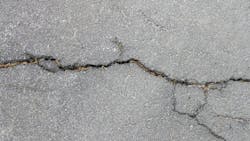Calif. subsidence continues with slower pace
The Calif. Department of Water Resources (DWR) released new satellite-based data showing that subsidence — the sinking of the land surface due to excessive groundwater pumping — continues in the state.
DWR has intensified its statewide subsidence monitoring to help identify impacts and address them collaboratively with local groundwater agencies, counties, and landowners.
The areas experiencing the most subsidence during Water Year 2021 (WY 2021) are in the San Joaquin Valley, with a maximum of 1.1 feet of subsidence observed in the region and the Sacramento Valley with a maximum of 0.7 feet in the region.
The latest data shows that, in WY 2021, subsidence of greater than 0.5 feet per year expanded to more areas than observed in WY 2020. However, fewer areas experienced higher rates of subsidence than at the end of the last drought in 2016.
“Californians rely on groundwater during drought, so it’s not surprising that land in some areas is continuing to sink,” said DWR Director, Karla Nemeth. “But it is good news that, compared to previous droughts, subsidence is slowing. . . Over time, recharging groundwater basins when it's wet and lowering demand for groundwater is the long-term solution to groundwater sustainability and subsidence.”
The new data covers satellite maps retrieved from October 2020 to September 2021 for more than 140 groundwater basins. DWR secured funding last year to increase the collection and reporting frequency of statewide satellite-based subsidence data from annually to quarterly to provide more real-time information. Beginning this year, data will be updated four times a year to help local, state, and federal agencies make informed management decisions backed by science-based data.
Local and state agencies are taking action in regions where subsidence has occurred the most over the last water year.
Groundwater Sustainability Agencies (GSAs) are implementing Groundwater Sustainability Plans (GSPs), including taking actions to monitor and address subsidence caused by groundwater pumping. The Sustainable Groundwater Management Act set forth a statewide regulatory framework for improving groundwater conditions over the next 20 years to safeguard groundwater as a reliable resource for future droughts and continuing climate change.
Current actions to manage impacts of subsidence include:
- Along the California Aqueduct in western Fresno and Kings counties, to address past and future subsidence impacts to this critically important infrastructure, DWR is working with federal agencies and with local GSAs that are implementing specific projects and management actions defined in their groundwater sustainability plans.
- Along the Friant-Kern Canal in Tulare County, on January 25, DWR, the U.S. Bureau of Reclamation and Friant Water Authority, broke ground on a $187 million construction project to restore capacity in a 10-mile portion of the canal, marking the beginning of work to restore a total of 33 miles of the existing Friant-Kern Canal that has previously been damaged by subsidence.
- In the San Joaquin Valley, DWR last month released GSP assessments for many of the groundwater basins in Merced, Madera, Fresno, Kings, Tulare, and Kern counties. DWR staff are meeting with local GSAs in these basins to address deficiencies identified in the assessmentsto help them monitor and manage subsidence moving forward.
- In the Sacramento Valley, in the Colusa and Yolo subbasins in Glenn, Colusa, and Yolo counties where subsidence has been documented, the local GSAs submitted their GSPs to DWR in January 2022 and they are beginning to implement those GSPs, including projects to address subsidence.
The amount of subsidence in specific regions varies over time based on many local factors, including pumping, water levels, geology and water year type. DWR’s California’s Groundwater Live is an interactive mapping tool that can be used to view the latest information on land subsidence in California based on DWR’s satellite-based data and continuous global positioning system station datasets.
